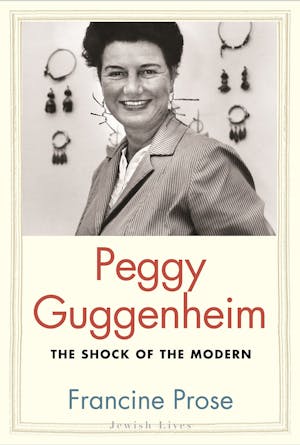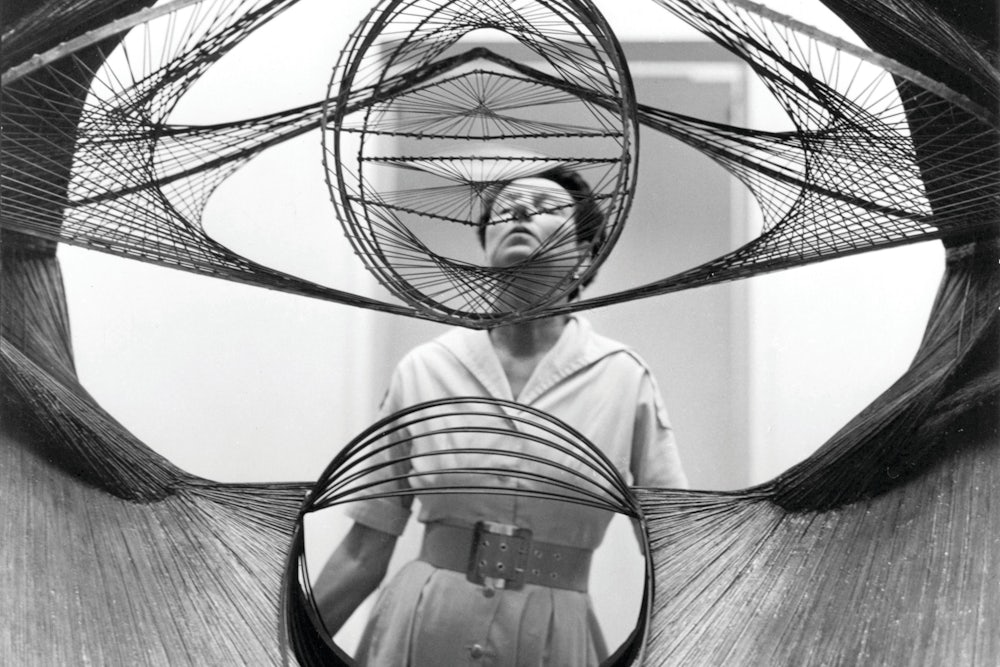“SHE DID IT... no matter what her motivations were, she did it.” Lee Krasner’s final verdict on what one should say about Peggy Guggenheim has an aphoristic appeal, and it’s easy to understand why Francine Prose should invoke it more than once in the course of her new biography, Peggy Guggenheim: The Shock of the Modern. Given how many longer and less flattering things have been said on the matter, including by the subject herself, the briskness with which Krasner sweeps aside Peggy’s muddled personal life to concentrate on her achievements is refreshing. (No one, including her most recent biographer, seems to call her “Guggenheim.”) Yet what exactly is “it” that Peggy did?
Collector, patron, dealer, and later the founder of her own museum, Peggy Guggenheim managed to be at the center of the modern art world for nearly half a century by doing almost everything with art other than making it. A partisan of surrealism and abstraction alike—she once wore an earring by Yves Tanguy with another by Alexander Calder to signify her impartiality between the schools—she was also a sexual adventuress, whose partners included a number of the artists she patronized. The mythologizing of her erotic exploits in the 1946 version of her memoir prompted Herbert Read to compare her to Rousseau and Casanova; Prose, who admires the memoir’s style more than I do, calls the final version from 1979 “fully as well crafted, as original, and engaging” as Djuna Barnes’s novel Nightwood. (Barnes, who wrote the novel while living in a communal household with Peggy and others in the English countryside, was a lifelong recipient of her friend’s generosity.)
Peggy helped to publicize a list of painters and sculptors whose names continue to resonate in the history of modernism, both in London—where she opened in 1938 the critically acclaimed gallery Guggenheim Jeune, so-called to distinguish it from the place her stodgier Uncle Solomon was about to open across the Atlantic—and later in New York, where she presided over Art of This Century, an experimental combination of museum and gallery. An inventory drawn up in 1942 for Art of This Century includes, among others, Jean Arp, Constantin Brancusi, Georges Braque, André Breton, Alexander Calder, Marc Chagall, Giorgio de Chirico, Joseph Cornell, Salvador Dalí, Robert Delaunay, Marcel Duchamp, and Max Ernst—and that’s just the first five letters of the alphabet.

Among the “P’s” one can spot Francis Picabia and Pablo Picasso but not yet Jackson Pollock, the artist whose career Peggy would launch with an exhibit in 1943 and whom she would later consider her greatest discovery. Though her first take on his work was hardly promising—”Pretty awful, isn’t it?” she observed of the canvas Pollock had submitted to her Spring Salon for Young Artists earlier that year—Piet Mondrian, to whom she was speaking, thought otherwise; and Peggy was nothing if not a quick study, especially when an authoritative man was laying down the word. Her contract with Pollock, which arranged for a guaranteed income in advance of sales, allowed the artist to quit his handyman job at her uncle’s museum and devote himself full time to painting. Two years later, he and Krasner were officially married, and Pollock’s prices began to take off near the end of the decade. This was surely part of what Krasner had in mind when she spoke of what Peggy did.
In 1947, Peggy closed Art of This Century and moved to Venice, where she was invited to install her collection in the unoccupied Greek pavilion of the 1948 Biennale—an occasion that gave many on the Continent their first view of the abstract expressionists. (Peggy herself quipped that seeing the name of Guggenheim on the maps next to Great Britain, France, and the rest made her feel like “a new European country.”) That year she acquired an eighteenth-century palazzo in the same city that would serve for the rest of her life as both residence and museum. The public was admitted three days a week, while the owner escaped to the roof to sunbathe. Houseguests sometimes found themselves shooing strangers from their rooms: an arrangement whose mix of exposure and privacy, generosity and thoughtlessness, was pure Peggy.
Though an Italian-born princess told her that she would have “the most beautiful house in Venice” if only she would throw “all those awful pictures” into the Grand Canal, the visitors, famous and otherwise, kept coming. Truman Capote wrote a book there; Tennessee Williams, Mary McCarthy, and Prince Philip attended her parties; Gregory Corso wrote to Alan Ginsberg of “dancing through Picassos and Arps and Ernsts with Peggy Guggenheim.”As Peggy herself demonstrated, hers is a life that is almost impossible to describe without dropping more than a few names.
Her own last name helped, of course, and so did the money. But Peggy saw herself as a dark sheep among the Guggenheims, and as Prose makes clear, by family standards—or those of our own Gilded Age—she wasn’t all that rich. Though Djuna Barnes thought Peggy had $70 million in 1931 (which, in 2015, would be worth more than $1 billion), the actual sums were far more modest. Her beloved father Benjamin Guggenheim, who went down with the Titanic in 1912, had left his affairs in serious disarray, and by the time Peggy came of age, she had become accustomed to thinking of herself as “no longer... a real Guggenheim.” Prose reports a first inheritance of $450,000—the rough equivalent, she says, of $5 million today—and a second identical sum when Peggy’s mother died in 1937. (Her maternal relatives, the Seligmans, came from a prominent German-Jewish banking family that looked down on the mining Guggenheims as parvenus.)
But in having fled the haute bourgeoisie of her childhood for bohemia as soon as she could, Peggy managed to ensure that she would always be the richest person in the room: both the benefactress on whom the others depended and the target for endless complaints of her stinginess. Her friend Emily Coleman, who couldn’t decide “whether Peggy is a saint or the meanest person I have ever met,” reported that “she actually gives away 3/4 of her income, to a point where she is worried, sometimes, whether she has enough money to buy herself a dress.” Among the recipients of her bounty were not only artists, but also striking British miners and the anarchist Emma Goldman, whose memoirs Peggy helped bankroll. At the same time, she was not above striking a hard bargain with those who needed her cash. A famous chapter of her autobiography gleefully boasts of how she scoured the studios of prewar Paris, determined to buy up “a picture a day” while the Germans threatened to invade: “The day Hitler walked into Norway, I walked into Léger’s studio and bought a wonderful 1919 painting from him for one thousand dollars.” In Peggy’s deadpan narrative, the surrealist absurd consorts happily with colossal egotism.
She told that story in her 1946 memoir Out of This Century. But the fact that Peggy originally intended to title it Five Husbands and Some Other Men suggests that even in her late forties, she wasn’t quite sure whether she should be celebrated for what she did or for the men she did it with. According to Prose, Peggy once boasted of having had over 400 lovers, but legally speaking, at least, there were only two husbands, rather than five, so her counts in these matters shouldn’t be taken too literally. The documented cases, at any rate, are numerous enough: Samuel Beckett, Giorgio Joyce, Yves Tanguy, Constantin Brancusi, and Marcel Duchamp are only the most familiar names on the list. Her first marriage, to the bohemian artist and writer Laurence Vail, produced two children and a history of spousal abuse that set the dreary pattern for much that followed; her second, to Max Ernst, was less obviously brutal—though he, too, seems to have beaten her—but no less demeaning, since Ernst seems to have taken up with her largely as a way of assuring his passage out of Europe during the war and as a meal ticket thereafter.
Prose does not speculate on the identities of the other “husbands,” but Peggy’s previous biographer, Mary V. Dearborn, thinks they were John Holms and Douglas Garman—two would-be writers with whom she lived in serial monogamy after her divorce from Vail—and, perhaps surprisingly, Beckett, whose on-and-off-again affair with the American heiress provides some of the more quietly comic moments in her history. Peggy, who claimed they once spent twelve days together in bed, called him “Oblomov” after the slothful aristocrat from Ivan Goncharov’s eponymous book.
While there were episodes of violence with both Holms and Garman, Peggy’s objection to Holms especially seems to have been more mental than physical: one of those men whom contemporaries regarded as a genius though he never produced anything, Holms appears in her account both as the love of her life and as a man who never said, “I don’t know.” Rather than find this alarming, Peggy treats it as part of his appeal, just as she would continue to fall in love—and into bed—with men who could double as teachers and advisers. Though her frenetic sex life has often been attributed to insecurity about her looks— she was particularly sensitive about her “potato nose,” which she thought still uglier after an aborted rhinoplasty in her early twenties—Peggy’s sense of intellectual inadequacy could prove equally corrosive.
Yet something clearly changed after she broke with Garman and came into her second inheritance in 1937—the year in which she decided to open her first gallery in London. “I am in Paris working hard for my gallery and fucking,” she wrote to her friend Emily Coleman the following January; and when Coleman remonstrated, Peggy wrote back to reassure her: “My fucking is only a sideshow. My work comes first every time. ...”
Coleman once speculated that Peggy’s fantastic self-absorption made her “in some curious way an artist,” and perhaps we should think of her as a kind of performance artist avant la lettre: Even the masochistic scenes might perversely qualify. Or perhaps we should focus on how her collaboration with the modernist architect and designer Frederick Kiesler turned Art of This Century into “a cross between an amusement park, a haunted house, and a Paris café,” as Prose nicely puts it, a precursor of today’s bustlingly popular museums. Peggy’s eye for art seems all the more forward-looking when we recall the stance of established museums in her day: The director of the Tate once ruled that her Arps and Brancusis didn’t qualify as sculpture for customs purposes, while the Louvre refused to store her collection during the war on the grounds that it wasn’t worth saving.
But in one respect, at least, her attitude toward art was distinctly old-fashioned. When she returned to New York in 1959, she was “thunderstruck,” as she put it, to discover “the entire art movement had become an enormous business venture”:
Only a few persons really cared for paintings. The rest bought them from snobbishness or to avoid taxation, presenting pictures to museums and being allowed to keep them until their death, a way of having your cake and eating it... Prices were unheard of. People only bought what was most expensive, having no faith in anything else. Some bought merely for investment, placing pictures in storage without even seeing them, phoning their gallery every day for the latest quotation, as though they were waiting to sell stock at the most advantageous moment.
She thought art had “gone to hell, as a result of the financial attitude.” One wonders what she’d say now.
